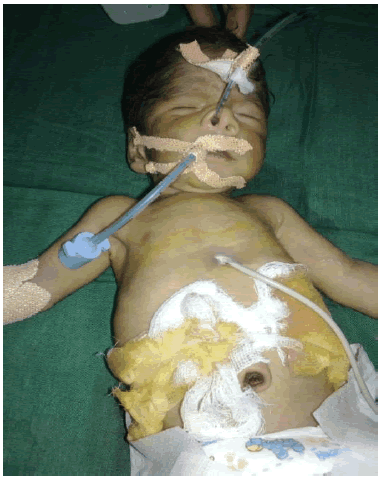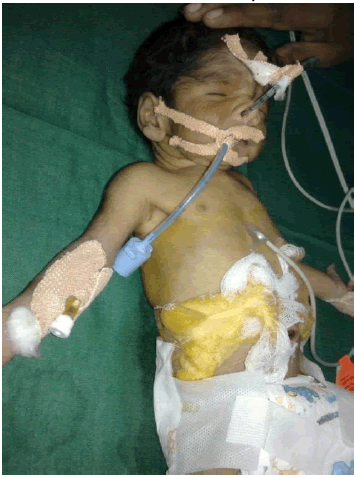ISSN: 2319-9865
ISSN: 2319-9865
Varaprasad Raghupatruni*
Department of Anaesthesiology, Maharajah’s Institute of Medical Sciences, Vizianagaram, Andhra Pradesh, India.
Received:29 July 2013Accepted:01 September 2013
Visit for more related articles at Research & Reviews: Journal of Medical and Health Sciences
Unanticipated difficult intubation is a challenge to the anesthesiologist mainly in intestinal obstruction cases in view of risk of aspiration. Here, we present a rare case of a 2day old neonate with anorectal malformation and transverse colon perforation posted for colostomy and successful management using sevoflurane as the main anesthetic.
Ano rectal, Infant, anesthetics.
A 2day old neonate, male, weighing 2kg presented with anorectal malformation and bowel obstruction posted forcolostomy. There were no other congenital malformations. On examination, cry was feeble, absent anal opening, moderate buttock folds, abdomen distended, visible loops present, heart rate-150/min, cardio-respiratory examination was normal. The patient was pre-oxygenated and pre-medicated with inj.glycopyrrolate-0.02mg, induced with sevoflurane (4%), laryngoscopy performed and intubated successfully with a 3mm uncuffed ETT, bilateral air entry and chest movements confirmed and tube fixed at 10cm at the angle of the mouth. Since maintenance of saturation was possible, the case was being continued with intermittent positive pressure ventilation using nitrous oxide, oxygen and sevoflurane (0.25-0.5%) mixture. After the surgery was completed, sevofluorane and nitrous oxide were stopped and the patient ventilated with 100%oxygen.The patient started to take good spontaneous respiration. Later, oro-pharyngeal suctioning was done to remove the secretions and the neonate was kept on spontaneous respiration and monitored with ETT insitu. After examining the vitals and checking bilateral air-entry was equal on both the sides and no sign of distress was present, the patient was being shifted to neonatal intensive care unit for further management [1-3].
Sevoflurane is a volatile anaesthetic, potent to be administered as a single anesthetic agent. Its potency, pleasant smell, lack of bronchoirritant effects makes it useful in operations on patients, particularly small children who need inhalational induction. It decreases bronchoconstriction by relaxing bronchial smooth muscles, allows administration of high inspired oxygen concentration, provides stable level of muscle relaxation, causes moderate degree of hypotension thereby decreases blood loss and is rapidly eliminated through lungs which allow prompt return of protective airway reflexes among patients. Here, we avoided muscle relaxants and maintained on oxygen, nitrous oxide and sevoflurane mixture. Sevoflurane is similar as induction and maintenance anaesthetic and there are limited complications and side-effects. Thus, we managed the case successfully [4,5].

